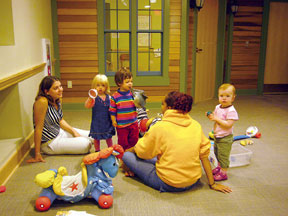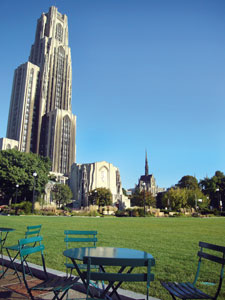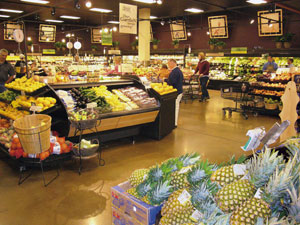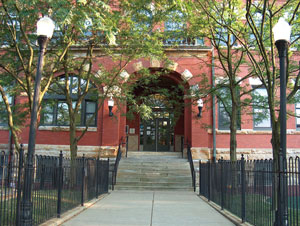Beyond Black and Gold The East End Goes Green
Holiday 2006
Earn one point for abating and developing a brownfield site, two for recycling 75% of construction waste, and another point for providing two preferred parking places for hybrid cars. Welcome to the environmentally friendly game of green building.
These and many other potential credits are based on a formalized system developed by the U.S. Green Building Council which awards those doing either new construction or renovation with Leadership in Energy and Environment Design (LEED) certification—in simplest terms, anointing it a “green building.”
Would it surprise you to learn that Pittsburgh ranks third in the country—behind Sacramento and Portland—in the amount of green square footage?
Steel city to green city?
“I think the vision of Pittsburgh being a world capital of green building is very real,” says Rebecca Flora, executive director of the Green Building Alliance, the local facilitator and advocate for environmentally responsible building design, construction and operating practices. “And I think we are well on our way. When you combine all of the critical aspects of the number of projects we have, the capacity we have, the university leadership, and other aspects like the manufacturing base, there are a lot of different components that point to Pittsburgh.”

And, better yet, they point right to our neighborhood.CS
For instance, the Carriage House Children’s Center in Squirrel Hill is raising 2.2 million dollars to complete a total renovation of the Wightman School Community Building that will, as executive director Natalie Kaplan says, “make this the only early childcare educational program and community facility in an historic building that will be going green.”
Architect Gary Moshier explains that the Carriage House will be earning LEED points for recycling as well as for its ongoing policies and operating procedures. “Just the mechanical contractor alone took about 32 tons of steel and iron out of the 110 year-old building and put it back into the scrap system; so it will be showing up in an automobile near you,” jokes Moshier. “They will also be rewarded for reducing their energy usage, the eco-friendly cleaning and pest control materials they use, and for a green curriculum that teaches kids what sustainability is all about.”

Informing the next generation about sustaining the environment is also a priority at Shady Side Academy’s senior school in Fox Chapel, where Rowe Hall Complex just underwent a renovation for which it hopes to receive LEED silver certification. “By going green in a school where we are preparing young people to assume their role in the future,” says Tom Thompson, director of physical plant, “students can come to understand that the whole green concept can certainly have beneficial effects down the road.” Thompson has a long history of instituting energy-saving measures at the school. “When I first started here,” he recalls, “the then president, Emerson Johnson, said to me, ‘Tom, every dollar that I don’t have to give to Equitable Gas or to Duquesne Light is another dollar I have for education.’”
Thompson says that even though he has always been energy conscious, the LEED process “turned it up a notch,” making it possible for a variety of energy-saving devices to be considered during the design and certification process that was funded as part of a $900,000 grant from the Richard King Mellon Foundation. As an example, occupancy sensors in Rowe Hall classrooms will not only shut off the lights, but also turn the heat down when the room is empty. Factoring in heat pumps and an energy recovery system, a total savings on power of 43% is predicted.

Another foundation, The Heinz Endowments, insists on green
construction when providing funding for bricks and mortar.
Caren Glotfelty, environment program director, says, “If we make grants for capital improvements, whether to colleges or universities or other non-profits, we will require them to do green building.” In one case, their $500,000 grant enabled the Pittsburgh Glass Center (PGC) to convert a former Studebaker showroom on Penn Avenue in Friendship into one of the best glass centers in the country. Encouraged by The Heinz Endowments, PGC captures the heat from the 2200 degree furnaces in the hot shop, providing heat to the whole building during the winter.
Pittsburgh Glass Center also earned points toward LEED gold certification when it incorporated used construction materials, such as the corrugated siding that was once part of Slippery Rock University’s field house. It was found at Construction Junction, a non-profit recycling center located in Point Breeze. As an indicator of the pace at which the green industry is growing, Construction Junction’s executive director, Mike Gable, says he has seen an average growth rate of 20% per year over the past seven years. In the hierarchy of maintaining a sustainable environment, Mike explains, reuse is at the top. “Reuse extends the useful life of building materials,” he says. “People in the green building world would label it as conserving the embodied energy of materials.”

onstruction Junction receives 90% of its materials, such as windows, sinks, revolving doors, and any other reusable building materials through donations. For instance, Phipps Conservatory and Botanical Gardens donated the exterior light fixtures that were removed as part of the project to create a new Welcome Center, which is the first in a public garden to be LEED certified. And that Welcome Center was just the beginning.
In December, Phipps opens its new 12,000-square-foot Tropical Forest. Executive director, Richard Piacentini, says it will incorporate numerous “eco-friendly and eco-smart” elements. “We said, let’s not build a conservatory the way they always build them,” he begins, before describing the traditionally-shaped conservatory that uses single-pane glass, whitewashed to filter out some of the sunlight. “What if we change the shape and make a very tall south-facing wall of single-pane glass, letting all of that winter sunlight come in for the plants, so that we can make the roof double-pane glass? This is one of the first conservatories to use that strategy.” Phipps engineers predict that change alone will save 30% on their heating bills.

Phipps has also installed computer-controlled energy blankets in the production greenhouses houses to retain heat at night, and will be the first conservatory in the world powered by a fuel cell. In the future, leftover plants and café waste will be converted to compost with the resulting methane run up through the fuel cell to produce electricity. Piacentini is barely able to contain his enthusiasm. “I have to tell you,” he says, “Phipps is actually the leading garden in this country right now for green sustainable practices and buildings. There’s not even a close second to what we are doing here.”
While Phipps is totally green on the inside, Oakland’s Schenley Plaza is green on the outside. Meg Cheever, president of the Pittsburgh Parks Conservancy (PPC), credits the entire Oakland and Pittsburgh community for getting behind the effort which has received overwhelmingly positive feedback. “The conversion of Schenley Plaza from an asphalt parking lot into a vibrant public green space does so much for Oakland and the surrounding region,” says Cheever. “It is a wonderful enhancement to the area where people can relax and be outside in a very comfortable and healthy way.”

Various green design techniques help the PPC reduce maintenance costs so that more time and funds can go back into the park. For example, the plaza’s soil was custom-designed for maximum absorption of storm water to prevent pooling and erosion, and an underground irrigation system serves the gardens and minimizes loss of water to sidewalks and paved areas.
The type of thinking and collaboration that went into creating Schenley Plaza is exactly what Rob Stephany, director of real estate development at East Liberty Development, Inc. (ELDI) has in mind when he describes what is being called “The Green Vision for East Liberty.” A design team will be contracted to take a comprehensive view, Stephany says, “a bird’s-eye look at the neighborhood in a larger eco- and recreational context” to take advantage of any natural features or resources, while considering everything from bike paths to parklets, sewer lines to water lines. “We want to tint our existing community green,” says Stephany, “so that it sets the framework for some of the change that’s about to unfold.”

Some of that change is being accomplished by The Mosites Company, the developer doing the new mixed retail complex on Centre Avenue called Eastside, which sits adjacent to its first project on that site—Whole Foods Market. Mark Minnerly, a partner in the project, credits ELDI for being their “community sponsor” along with the Green Building Alliance, the Community Loan Fund, and The Heinz Endowments. He recognizes them as being “critical resources and the energy behind making Eastside possible.”
Marc Mondor, a green building consultant with evolveEA, is guiding the Eastside developers toward LEED silver. LEED points will be awarded for taking over a contaminated brownfield site that was once occupied by a car wash and the Yellow Cab Company and for being a good neighbor. “The developers are building some very high quality architectural buildings here,” says Mondor. “The fact is that Eastside and the adjoining Whole Foods have become a center where you can go to work, shop for groceries, have a coffee, get a massage, buy a book, and more; and, when it’s all said and done, the biggest impact these buildings will have on sustainability is actually how well they fit into the overall fabric of an East Liberty that is being revitalized.”
Chris Minnerly, principal with The Design Alliance, the architectural firm for Eastside, explains that applying for LEED certification for its “core and shell” leaves it up to each individual tenant to decide if they want to pursue LEED certification for their interior. “Right now it’s been our experience that tenants often aren’t interested in LEED,” says Minnerly, who adds that national retail chains, for instance, might have a particular formula for finishing the interior that seems to work, but which doesn’t necessarily follow any green guidelines.
The exception to the rule is PNC—primary lender and tenant in Eastside, where PNC opened a new branch this fall. In fact, PNC, with more green buildings than any other corporation in America, has been way ahead of the green curve for a long time. Gary Saulson, director of corporate real estate and the champion behind the whole green movement in the company, says he not only saw it as the right thing to do, but that PNC wouldn’t do it unless it had a payback. “We see it as a competitive advantage,” says Saulson, describing how employees thrive in the open, airy atmosphere. “When you look at turnover, sick days, and employee surveys, all of the feedback we have been able to gather has been positive with regard to the environment we are providing. And our customers love it.”

jim lampl [sic], director of conservation for Giant Eagle, would agree with PNC’s cost/benefit analysis. One of the O’Hara-based company’s supermarkets, located outside of Cleveland, was the first in the country to obtain LEED certification. And after investing $40 million in the Market House condominium tower and the upscale Market District grocery store (formerly known as Giant Eagle) upon which it sits, at Negley and Centre avenues in Shadyside, Giant Eagle is applying for LEED gold for commercial interiors. “A lot of the environmental benefits have a good payback,” says lampl, “especially with the energy efficiency; and customers and employees just seem to love the natural lighting.”
lampl refers to the store’s atmosphere as “urban cool for foodies.” But one of its most innovative green elements happens to be located on the roof where a 12,000-square-foot garden has been planted with ground cover and is irrigated by natural rainfall. The University of Pittsburgh has set up flumes to enable the monitoring and comparison of rainwater run-off and water quality between the green roof and the adjacent conventional roof.

At Carnegie Mellon University, the New House residence hall is the first LEED-certified university residence in the country, one of many green projects that have helped make Pennsylvania the second-leading state for number of LEED-certified buildings.
The task of the Green Building Alliance has been to get invited to the table as soon as possible and dispel the perception that green has to cost significantly more. “There are several projects that have proven that’s just not true,” says Rebecca Flora. “We are seeing more of the developer community, bottom-line oriented folks, embrace green building. It’s starting to go mainstream.”
So the word is getting out due to the efforts of local professionals in the green community who form a tight-knit group that respects and acknowledges the talents of each its members. “We are the old timers,” says lampl. “We have been doing this long before there was LEED, and here it is years later catching on in a big way. We are very proud of just how strong the environmental and green building network is here, and Pittsburgh is the place to be, that’s for sure.”
With many thanks to SHADY AVE magazine for granting me permission to reprint on my website.


